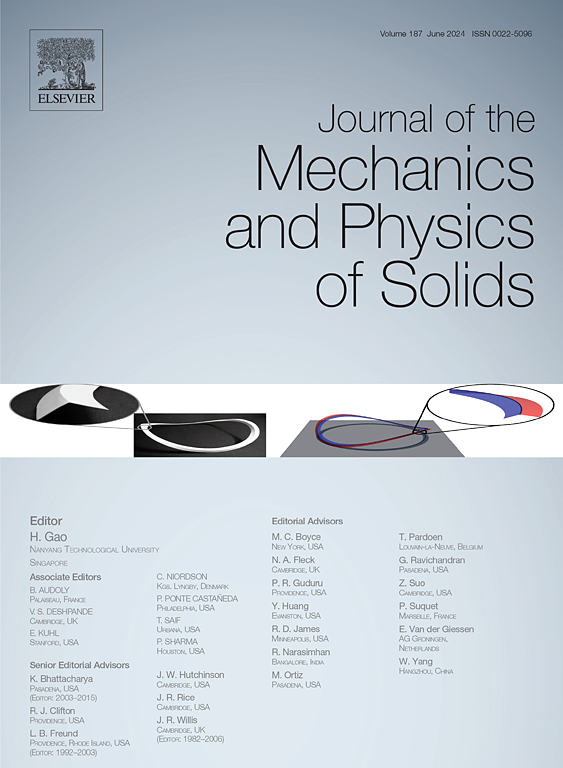Dynamic interplay of dendrite growth and cracking in lithium metal solid-state batteries
IF 6
2区 工程技术
Q2 MATERIALS SCIENCE, MULTIDISCIPLINARY
引用次数: 0
Abstract
All-solid-state batteries (ASSBs) represent a significant leap forward compared to conventional liquid-electrolyte based batteries, offering enhanced energy density, improved safety, extended cycle longevity, and reduced environmental footprint. However, the persistent challenge of uncontrollable dendrite growth within solid electrolytes (SEs) has posed substantial obstacles to the realization of Li metal ASSBs. This study develops a phase field model to unveil a dynamic interplay between Li dendrite growth and crack propagation in the polycrystalline Li7La3Zr2O12 (LLZO) solid electrolyte. Our modeling highlights distinct nucleation sites for Li electrodeposition, localized in proximity to the electrode/SE interface, a phenomenon sensitive to cell geometry. Li deposition initiates local stress accumulation that wedges the SE to cracking, and fracture induced stress relaxation facilitates further Li electrodeposition. Remarkably, a reciprocal relationship emerges between Li dendrite growth and crack propagation, each process reinforcing the other in an alternating manner. The dynamic interplay unveils a characteristic “wait-and-go” temporal sequence, where the progression of Li dendrites consistently trails behind the crack tip, aligning with the previous experimental observations. Drawing from the reciprocal dynamics, we identify practical stress-engineering strategies to mitigate catastrophic cell failure by simultaneously retarding Li dendrite growth and redirecting the crack propagation paths. Our findings offer electrochemo-mechanical insights in cell design and stress management, thereby opening a unique pathway towards the realization of safe and durable Li metal ASSBs.
锂金属固态电池中枝晶生长与开裂的动态相互作用
与传统的基于液体电解质的电池相比,全固态电池(assb)代表了一个重大飞跃,它提供了更高的能量密度、更高的安全性、更长的循环寿命,并减少了环境足迹。然而,固体电解质(SEs)中不可控枝晶生长的持续挑战对锂金属assb的实现构成了实质性障碍。本研究建立了相场模型,揭示了多晶Li7La3Zr2O12 (LLZO)固体电解质中Li枝晶生长与裂纹扩展之间的动态相互作用。我们的模型突出了锂电沉积的不同成核位点,定位在电极/SE界面附近,这是一种对细胞几何结构敏感的现象。Li沉积引发局部应力积累,将SE楔入裂纹,断裂引起的应力松弛有利于进一步的Li电沉积。值得注意的是,在Li枝晶生长和裂纹扩展之间出现了一种互反关系,每个过程以交替的方式加强另一个过程。动态相互作用揭示了一个特征的“等待-走”时间序列,其中Li枝晶的进展始终落后于裂纹尖端,与先前的实验观察结果一致。根据相互动力学,我们确定了实用的应力工程策略,通过同时延缓Li枝晶生长和重定向裂纹扩展路径来减轻灾难性细胞破坏。我们的研究结果为电池设计和应力管理提供了电化学机械方面的见解,从而为实现安全耐用的锂金属assb开辟了一条独特的途径。
本文章由计算机程序翻译,如有差异,请以英文原文为准。
求助全文
约1分钟内获得全文
求助全文
来源期刊
CiteScore
9.80
自引率
9.40%
发文量
276
审稿时长
52 days
期刊介绍:
The aim of Journal of The Mechanics and Physics of Solids is to publish research of the highest quality and of lasting significance on the mechanics of solids. The scope is broad, from fundamental concepts in mechanics to the analysis of novel phenomena and applications. Solids are interpreted broadly to include both hard and soft materials as well as natural and synthetic structures. The approach can be theoretical, experimental or computational.This research activity sits within engineering science and the allied areas of applied mathematics, materials science, bio-mechanics, applied physics, and geophysics.
The Journal was founded in 1952 by Rodney Hill, who was its Editor-in-Chief until 1968. The topics of interest to the Journal evolve with developments in the subject but its basic ethos remains the same: to publish research of the highest quality relating to the mechanics of solids. Thus, emphasis is placed on the development of fundamental concepts of mechanics and novel applications of these concepts based on theoretical, experimental or computational approaches, drawing upon the various branches of engineering science and the allied areas within applied mathematics, materials science, structural engineering, applied physics, and geophysics.
The main purpose of the Journal is to foster scientific understanding of the processes of deformation and mechanical failure of all solid materials, both technological and natural, and the connections between these processes and their underlying physical mechanisms. In this sense, the content of the Journal should reflect the current state of the discipline in analysis, experimental observation, and numerical simulation. In the interest of achieving this goal, authors are encouraged to consider the significance of their contributions for the field of mechanics and the implications of their results, in addition to describing the details of their work.

 求助内容:
求助内容: 应助结果提醒方式:
应助结果提醒方式:


